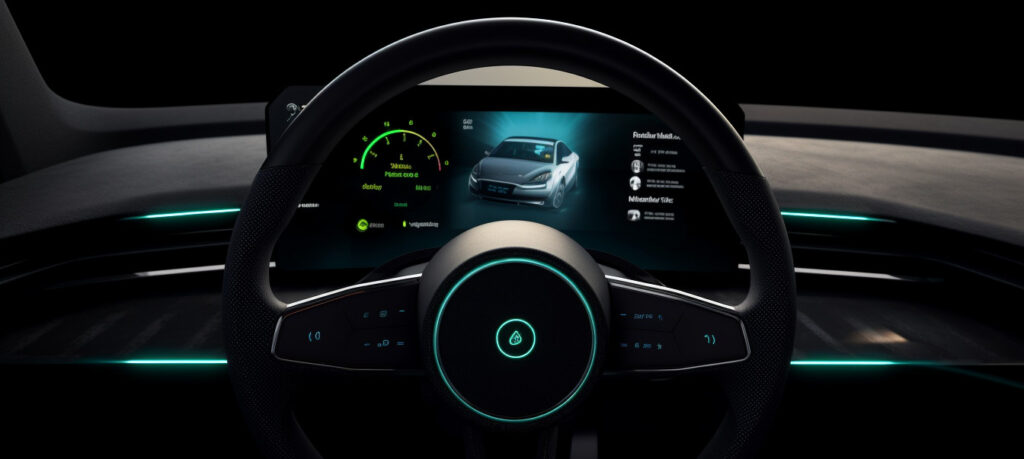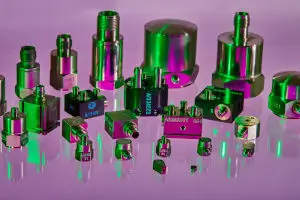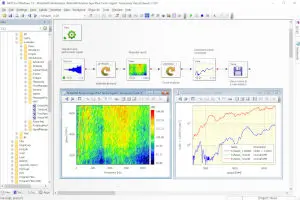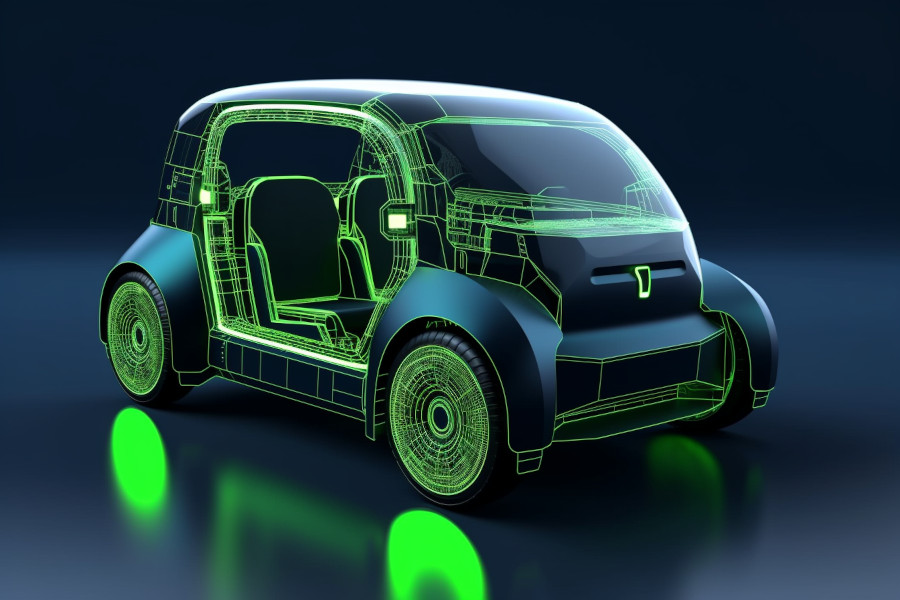Electric vehicle noise & vibration testing is crucial for vehicle development, ensuring the final product’s comfort, safety, and reliability. While electric vehicles (EVs) and internal combustion engine (ICE) vehicles undergo such testing, the nature and sources of the vibrations and noises differ significantly due to their distinct powertrain configurations.
How different or similar is acoustic & vibration testing of EVs and ICE vehicles?
Electric Vehicle Noise & Vibration Testing – Noise sources
For ICE vehicles, the primary noise sources are the engine, exhaust system, and mechanical components like the transmission and drivetrain. In contrast, EVs have fewer moving parts. The primary noise sources are the electric motor, power electronics, cooling system, and road and tire noise. As a result, EVs’ acoustic profile tends to differ from that of ICE vehicles. They often require more focus on high-frequency noises and electric motor-related sounds.
In electric vehicles (EVs), noise sources differ from those in internal combustion engine (ICE) vehicles, primarily due to the absence of engine and exhaust noise. Major sources of noise problems in an electric vehicle include:
Electric motor: Electric motors can generate high-frequency tonal noise, especially during high-speed operation or under heavy loads. This noise can be caused by the interaction between the stator and rotor, torque ripple, or magnetic forces acting on the motor components.
Power electronics: Inverters and converters used in EVs for controlling the motor and managing the battery system can produce high-frequency switching noise, which may be audible inside the cabin or radiate externally as electromagnetic interference (EMI).

Gearbox and drivetrain: Gear whine, bearing noise, and other mechanical noises from the transmission or drivetrain can contribute to the overall noise levels in an EV, although these noises are typically lower in magnitude compared to those in ICE vehicles.
Cooling system: Electric vehicles require cooling systems for the battery pack, electric motor, and power electronics. Pumps, fans, and other cooling system components can generate noise, which may be transmitted to the vehicle interior or exterior.
Road and tire noise: Due to the reduced powertrain noise in EVs, road and tire noise become more noticeable. These noises are generated by the interaction between tires and the road surface, as well as the vibrations induced in the suspension system and vehicle structure.
Aerodynamic noise: As EVs generally operate more quietly than ICE vehicles, aerodynamic noise becomes more prominent. This noise is produced by the airflow around the vehicle body, side mirrors, and other exterior components, particularly at high speeds.
Structural vibrations: Vibrations from various sources can excite the vehicle’s structure, leading to noise transmission through the body and into the cabin. These vibrations can originate from road inputs, electric motor imbalances, or other sources.
Auxiliary systems: Additional sources of noise in EVs can include auxiliary systems such as air conditioning, vacuum pumps for brake systems, or electric power steering systems.
Addressing these noise sources is crucial in ensuring a comfortable and quiet driving experience for EV occupants. Engineers employ various testing and analysis methods to identify and mitigate noise issues in electric vehicles.
Electric Vehicle Noise & Vibration Testing – Test procedures

Electric Vehicle noise & vibration testing, like ICE vehicles, involves measuring the vehicle’s response to different inputs. These might include different road conditions, speeds, and operating states. These measurements are performed using accelerometers, microphones, and other sensors placed at critical locations throughout the vehicle.
However, the test procedures and focus areas may differ between the two types of vehicles. For example, in EVs, special attention is given to the electric motor and power electronics and potential issues like electromagnetic interference (EMI) that may impact the overall acoustic performance.
Electric Vehicle Noise & Vibration Testing – Test Methods
Various test methods play a crucial role in assessing and improving the vibration and acoustic performance of vehicles. These methods include laboratory testing, road testing, component testing, modal analysis, ODS analysis, and transfer path analysis. Each method offers unique insights into the vehicle’s dynamic behaviour, allowing engineers to identify and address potential NVH issues effectively. By employing these testing methods, engineers can develop vehicles with improved comfort, safety, and reliability, ensuring a pleasant driving experience for occupants.
i. Laboratory Testing
Laboratory testing offers a controlled environment for vibration and acoustic testing on vehicles. Anechoic or semi-anechoic chambers are commonly used for this purpose, as their design isolates external noise sources and reflects minimal sound energy back into the test space. These chambers have walls lined with sound-absorbing materials, such as foam wedges, which help obtain accurate acoustic measurements. In laboratory testing, engineers can simulate various operating conditions, like engine speeds, road loads, and temperature changes, by using dynamometers, shakers, or other specialized equipment. Data acquisition systems capture vibration and noise data from strategically placed sensors, such as accelerometers and microphones. Laboratory testing allows for precise measurements, repeatability, and controlled experimentation, enabling engineers to analyze the vehicle’s NVH characteristics, identify problematic areas, and evaluate the effectiveness of proposed design changes or noise reduction measures.
ii. Road Testing
Road testing involves driving the vehicle on real roads or test tracks with varying surfaces and conditions to evaluate its vibration and acoustic performance in real-world scenarios. To evaluate the vehicle’s NVH behaviour, road tests can simulate various driving scenarios, such as high-speed driving, cornering, and driving over rough surfaces. Accelerometers, microphones, and other sensors placed throughout the vehicle gather data, which is then analyzed to identify potential issues related to road noise, suspension performance, wind noise, and other factors. Road testing helps engineers validate and refine their laboratory test findings and identify any NVH issues that may be difficult to replicate in a lab setting. This type of testing is crucial for understanding how the vehicle’s NVH characteristics translate to real-world driving conditions and ensuring that the final product meets customer expectations and regulatory requirements.
Advertisement
Some examples of the products from the CMTG brands
DJB Accelerometers
Sense

- Piezoelectric charge & IEPE accelerometers
- Instrumentation, cables & accessories
- Calibration & repair service

Prosig DATS Hardware
Capture

- Rugged, mobile data capture
- Options inc. 24-bits @ 300k samples/sec
- From 4 to 1000’s channels

Prosig DATS Software
Analyze

- Don’t just test – gain insight from your data
- Huge selection of signal processing algorithms
- Optional application add-ons

iii. Component Testing
Component testing for noise and vibration issues evaluates individual components, such as electric motors, power electronics, cooling systems, and gearboxes, before integrating them into the vehicle. Testing components in isolation allows engineers to identify and address problematic areas early, reducing the likelihood of issues arising during vehicle-level testing. Component testing may involve using specialized test rigs or fixtures designed to simulate the component’s operating conditions, such as temperature, load, and speed. Various sensors, like accelerometers and microphones, capture vibration and noise data, which is then analyzed to understand the component’s dynamic behaviour and identify areas for improvement. Component-level testing is essential for managing the overall NVH performance of a vehicle, as it allows engineers to optimize each part individually and ensure that the integrated system meets the desired NVH targets.
iv. Modal Analysis
Modal analysis is a technique used to investigate the dynamic behaviour of a structure or component by studying its response to a known input. In this method, the vehicle or its components are excited using an impact hammer, shaker, or other controlled excitation sources. Sensors, such as accelerometers and force transducers, measure the resulting vibrations, and the data is processed to extract the system’s modal properties. Modal analysis provides information about the structure’s natural frequencies, mode shapes, and damping ratios. This information is valuable for engineers to identify potential resonance issues, which can lead to excessive vibrations and noise during operation. By understanding the system’s modal behaviour, engineers can make informed decisions about design changes, material selection, or the addition of damping treatments to minimize the risk of resonance-related NVH problems.
v. Operational Deflection Shape (ODS) Analysis
Operational Deflection Shape (ODS) analysis is a technique used to visualize the vibration patterns of a structure during its normal operation. This method collects vibration data from various points on the structure while it operates under normal conditions, using sensors such as accelerometers. The data is then processed and visualized, often with the help of specialized software, to create animated deflection shapes that represent the structure’s vibration behaviour. These deflection shapes help engineers identify areas of high vibration and potential noise issues. ODS analysis is particularly useful for understanding the dynamic response of a structure under actual operating conditions, as opposed to the simplified or idealized conditions often used in modal analysis. Engineers can pinpoint problematic areas and develop targeted solutions to address specific NVH concerns by studying the ODS of a vehicle or its components. This technique can also be used to validate computer models and simulations, ensuring that they accurately represent the vehicle’s real-world dynamic behaviour.
vi. Transfer Path Analysis (TPA)
Transfer Path Analysis (TPA) identifies and quantifies the paths through which vibrations and noise travel from their sources to the vehicle’s interior or other areas of interest. TPA helps engineers understand the relative contribution of different paths and sources to the overall NVH levels in a vehicle, enabling them to prioritize and target the most significant contributors. TPA typically involves measuring the vibration or noise levels at both the source and receiver locations and the transfer functions that describe the transmission behaviour between these points. This data is then analyzed to estimate each path’s and source’s individual contributions to the overall NVH performance. By understanding the dominant transfer paths, engineers can develop targeted solutions, such as structural modifications, damping treatments, or isolation measures, to reduce the overall NVH levels in the vehicle and improve occupant comfort.

Electric Vehicle Noise & Vibration Testing – Types of Analysis
Several types of analysis can be performed on the collected data from vibration and acoustic testing. Some of the common types of analysis include:
i. Frequency Analysis
Frequency analysis involves decomposing measured vibrations and noise into their frequency components, enabling engineers to identify specific frequencies responsible for excessive noise or vibrations. Fast Fourier Transform (FFT) is a common algorithm used for this purpose. By analyzing frequency-domain data, engineers can pinpoint resonant frequencies, tonal issues, or other frequency-related concerns and develop targeted solutions, such as structural modifications, damping treatments, or isolation measures, to address these problems effectively.
ii. Time-domain Analysis
Time-domain analysis examines the time history of vibrations and noise, revealing transient events like impacts or sudden changes in operating conditions that may contribute to NVH issues. By studying time-domain data, engineers can assess the temporal characteristics of vibrations and noise, such as duration, onset, and decay. This information is useful for understanding the dynamic behaviour of the vehicle or its components under real-world operating conditions and developing strategies to mitigate time-domain-related NVH issues.
iii. Statistical Energy Analysis (SEA)
SEA is an approach used to estimate energy distribution and transmission within a complex system, such as a vehicle, by analyzing the interactions between subsystems. SEA is particularly useful for predicting high-frequency noise and vibration behaviour, whereas traditional methods like Finite Element Analysis (FEA) may be computationally expensive or less accurate. SEA helps engineers understand the overall energy flow within the vehicle, identify dominant transmission paths, and develop targeted solutions to reduce high-frequency NVH issues.
iv. Finite Element Analysis (FEA)
FEA is a numerical method used to analyze and predict the behaviour of structures and materials under various conditions, including vibrations and acoustics. By creating a computer model of the vehicle or its components, engineers can simulate different operating conditions and identify areas where noise and vibrations may be problematic. FEA allows engineers to optimize the vehicle structure and materials during the design stage to minimize NVH issues and validate the effectiveness of proposed design changes or noise reduction measures.
v. Boundary Element Analysis (BEA)
BEA is a numerical method similar to FEA but focuses on the boundaries of a structure rather than its entire volume. This approach is often used in combination with FEA to model acoustic radiation and predict how sound waves propagate through and around a vehicle’s structure. BEA helps engineers understand the vehicle’s exterior acoustic behaviour, identify potential noise radiation issues, and develop targeted solutions to mitigate these problems.
vi. Experimental Modal Analysis (EMA)
EMA involves measuring the dynamic response of a structure to a known excitation and then using this data to estimate its modal properties, such as natural frequencies, mode shapes, and damping ratios. This information helps engineers identify and address potential resonance issues that may lead to excessive vibrations and noise. EMA can be used to validate computer models, simulations, and other analytical predictions of the vehicle’s dynamic behaviour, ensuring that they accurately represent real-world performance.
vii. Sound Quality Analysis
Sound quality analysis assesses the subjective perception of the vehicle’s noise signature, focusing on metrics like loudness, sharpness, tonality, and fluctuation strength. By understanding the perceptual aspects of the vehicle’s noise, engineers can optimize the acoustic experience for occupants and meet specific sound quality targets. Sound quality analysis can involve subjective evaluations by human listeners or objective measurements using specialized algorithms and software tools, providing valuable insights into the overall acoustic performance and customer satisfaction.
Summary
In summary, vibration and acoustic testing for both ICE and electric vehicles have common goals and methodologies, but the differences in their powertrains, noise sources, and acoustic profiles necessitate different testing procedures, focus areas, and targets. Engineers working with EVs must address the unique challenges posed by electric motors, power electronics, and the absence of traditional combustion engine noise.
Various test methods, such as laboratory testing, road testing, component testing, modal analysis, and ODS analysis, are employed to measure and analyze vehicles’ vibration and acoustic performance. Additionally, several types of analysis, including frequency, time-domain, statistical energy, finite element, boundary element, experimental modal, and sound quality analysis, can be performed on the collected data to identify and address potential NVH issues.
By understanding the unique challenges posed by EVs and employing appropriate test methods and analysis techniques, engineers can develop vehicles with improved comfort, safety, and reliability, ensuring a pleasant driving experience for occupants.
Chris Mason
Latest posts by Chris Mason (see all)
- Rotating Machinery Vibration Analysis: Keeping Your Machines Humming Along - November 27, 2023
- Vibration Control and Isolation: A Comprehensive Guide for Engineers - November 6, 2023
- Modal Analysis in the Real World - October 6, 2023



Thanks for this summarizing technical note about the NVH testing of EVs.